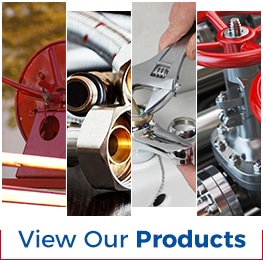
Pneumatic power works by converting the potential energy stored in compressed gasses into kinetic energy. Pneumatic systems are those that use pneumatic power to perform various types of mechanical work. These types of systems use compressed air or gasses to transmit and control the output of mechanical energy.
Pneumatic systems are used across a wide range of industries, including manufacturing, aerospace, automotive, construction, food and beverage, mining, petrochemical, and textile industries. Pneumatic power provides many advantages: it’s simple to use, provides reliable levels of pressure, is cost-effective, and doesn’t generate a lot of pollution. Some of the ways pneumatic power is used include:
- Pneumatic tools (pneumatic drills, jackhammers, riveters, impact wrenches, nail guns, paint sprayers, etc.)
- Manufacturing equipment (assembly lines, conveyors, sorters. machining. etc.)
- Air brakes
- Automation and robotics
- High volume printing
- HVAC systems
- Mining (rock drilling tools, material transport, ventilation, etc.)
- Dental drills and other medical equipment
- Packaging
- Valves, pumps, and other equipment in chemical processing.
The Components of a Pneumatic System
The compressor is the most essential component in a pneumatic system. Compressors use electric, gas, or diesel motors to take in the ambient air and compress it to the desired pressure. The compressed air is stored in a receiver tank (also known as an air reservoir) until needed. Air treatment components inside the compressor help prevent moisture, oil, and other contaminants from entering the system.
Hoses, fittings, connectors, valves, and gauges are also important components of a pneumatic system:
- Hoses connect the different components and allow air to flow through a pneumatic system.
- Fittings and connectors are used to connect and secure the hoses. An airtight fit is necessary to maintain pressure within the system.
- Valves are used to control the flow and direction of airflow within a pneumatic system.
- Pressure gauges provide real-time measurements of the air pressure, This allows personnel to monitor, adjust, and maintain pressure levels inside a pneumatic system, ensuring safe and efficient operation.
Leaks, power fluctuations, underpowered machines or equipment, environmental factors, and air quality issues are just a few of the problems that can affect the performance of a pneumatic system. Selecting the right components for a pneumatic system is essential for optimum efficiency. Regular inspections and maintenance can prevent a lot of operational problems.
Pneumatic Components from ASJ Industrial Hose and Fittings
ASJ Industrial Hose and Fittings Have been serving the construction, heavy machinery, oil & gas, concrete, chemical, and food & beverage industries since 1982. Based in Corona, CA, we’re one of North America’s largest suppliers of hoses, clamps, fittings, valves, gauges, and other components used in hydraulic and pneumatic systems. We carry a broad selection of products from some of the top manufacturers in the industry. Our experienced sales personnel are here to help you find the right items for your applications. You can contact ASJ Industrial Hose and Fittings through our website or call us at (951) 735-1351 to discuss your needs and get a quote. If you’re local to the area, you can also stop by our facility at 1033 E. 3rd St..



 Phone:
Phone: